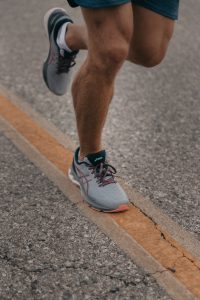 If getting into shape was one of your 2023 resolutions, you may be one of the hundreds now jogging, sprinting or running in Irvine, CA. Not all running shoes are the same. Walking shoes differ from shoes you use for jogging and those you use for sprinting. Sprinting has explosive movements for a shorter period. It helps burn fat, while building the legs and abs. Because it’s high intensity for a short period, it is a HIIT—high intensity interval training—workout, since the intensity volleys between high intensity and a recovery pace.
If getting into shape was one of your 2023 resolutions, you may be one of the hundreds now jogging, sprinting or running in Irvine, CA. Not all running shoes are the same. Walking shoes differ from shoes you use for jogging and those you use for sprinting. Sprinting has explosive movements for a shorter period. It helps burn fat, while building the legs and abs. Because it’s high intensity for a short period, it is a HIIT—high intensity interval training—workout, since the intensity volleys between high intensity and a recovery pace.
Sprinting requires lighter footwear, since the goal is to get from start to finish the fastest.
Over 40 years of studies show that the lighter the weight of the shoe, the faster you’ll run. One specific recent study showed that for every 3.5 ounces added to the running shoe, the performance decreased and made the runner about 1% slower. However, if your goal is to burn calories and get into shape rather than competition, there are many reasons to avoid a lightweight shoe.
When is a lightweight shoe not recommended?
If you’ve suffered from foot injuries previously, you might not want a lightweight shoe for sprinting. Heavier shoes with a firmer insole add weight, but also absorb shock better, making them good for older individuals and those with joint problems. Generally speaking, wearing heavier running shoes offers better support and can prevent injuries, such as Achilles tendonitis or plantar fasciitis. Studies show that having heavier, but more cushioned shoes can be the best option for those who have had previous injuries to the foot and joints.
Getting traction is important.
When you’re sprinting, your heels are most often in the air, with just the balls of the feet doing most of the work. Spikes encourage good traction, so you use the power of the legs more efficiently. Its design allows the sprinter to get more push with each step. Spikes can either be made of plastic or hard rubber and fit under the front of the foot. Its very design forces the runner onto the balls of the feet. Spikes can be used on asphalt, gravel and dirt, but avoid using them on concrete.
- Lighter weight shoes wear out faster. The rule of thumb is to change shoes every 300 to 400 miles, but with lighter weight shoes, you should change them every 200 miles. Instead of three months of use, you might need to replace them in a little over a month.
- Some people opt for two pairs of shoes, heavier ones for training and lighter ones for racing. You do have to make sure that the designs are similar to avoid affecting your gait.
- Where you’ll be sprinting makes a difference. If you’re running on trails, you want one with a rock shield to protect the foot, but those running on hot asphalt need to maximize airflow to cool the foot.
- Stick with a shoe that feels comfortable, but still provides stability. It’s especially important if you’re exercising for fitness, not to actually race. If you need extra cushioning, get shoes that provide it and you’ll be more apt to stick with your exercise program.
For more information, contact us today at Next Level Fitness
